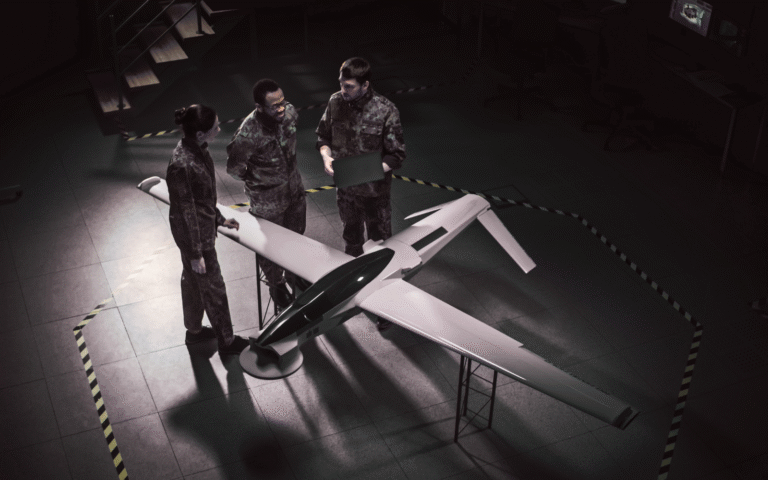Executive Summary
Mobile application development cost structures within defense and space systems architecture demand specialized analysis beyond conventional commercial development metrics. The financial implications of mission-critical mobile applications in aerospace environments require a comprehensive evaluation of security compliance frameworks, real-time data processing capabilities, and system integration complexities that exceed standard enterprise mobile solutions by factors of 3-7x in total cost of ownership.
Defense contractors and space systems integrators face unique cost variables including NIST 800-171 compliance requirements, satellite communication protocol integration, and fault-tolerant architecture design specifications. These technical parameters fundamentally alter baseline mobile application development cost calculations through mandatory security controls, specialized testing protocols, and integration with classified network infrastructures.
The analysis reveals three primary cost multipliers specific to defense and space applications: security compliance overhead (35-45% of base development cost), specialized hardware integration requirements (20-30% additional complexity), and mission-critical reliability testing protocols (40-60% of development timeline extension). Understanding these cost drivers enables accurate project estimation and resource allocation for government contractors pursuing mobile technology integration within existing defense and space systems portfolios.
Key Technical Findings and Cost Implications
| Cost Category | Commercial Mobile Apps | Defense/Space Mobile Apps | Multiplier Factor |
| Base Development | $150,000 – $300,000 | $450,000 – $900,000 | 3.0x |
| Security Implementation | $25,000 – $50,000 | $157,500 – $405,000 | 6.3x |
| Testing & Validation | $30,000 – $75,000 | $180,000 – $540,000 | 7.2x |
| Integration Complexity | $40,000 – $80,000 | $200,000 – $480,000 | 6.0x |
| Maintenance (Annual) | $50,000 – $100,000 | $225,000 – $540,000 | 5.4x |
Defense and space mobile applications require specialized mobile application architecture that accommodates secure enclaves, encrypted communication channels, and real-time telemetry processing capabilities. These architectural requirements significantly impact development cost through specialized middleware development, custom API creation, and integration with legacy defense systems that often operate on proprietary communication protocols.
Technical Architecture Cost Analysis Framework
Security Architecture Implementation Costs
Defense-grade mobile applications mandate the implementation of multiple security layers that substantially increase mobile application development costs beyond commercial standards. The Department of Defense Architecture Framework (DoDAF) compliance requires specific security controls that directly impact development expenses through specialized encryption libraries, secure authentication mechanisms, and data segregation protocols.
| Security Component | Implementation Cost | Annual Maintenance | Technical Complexity |
| FIPS 140-2 Encryption | $75,000 – $125,000 | $25,000 – $45,000 | High |
| Multi-Factor Authentication | $45,000 – $85,000 | $15,000 – $30,000 | Medium |
| Secure Communications | $65,000 – $110,000 | $35,000 – $60,000 | High |
| Data Loss Prevention | $55,000 – $95,000 | $20,000 – $40,000 | Medium |
| Certificate Management | $40,000 – $70,000 | $18,000 – $35,000 | Medium |
The mobile application architecture for defense systems requires the implementation of specialized security frameworks including Common Access Card (CAC) integration, Public Key Infrastructure (PKI) certificate handling, and secure token service authentication. These components necessitate custom development approaches that increase baseline mobile application development cost through specialized cryptographic libraries and secure communication protocol implementation.
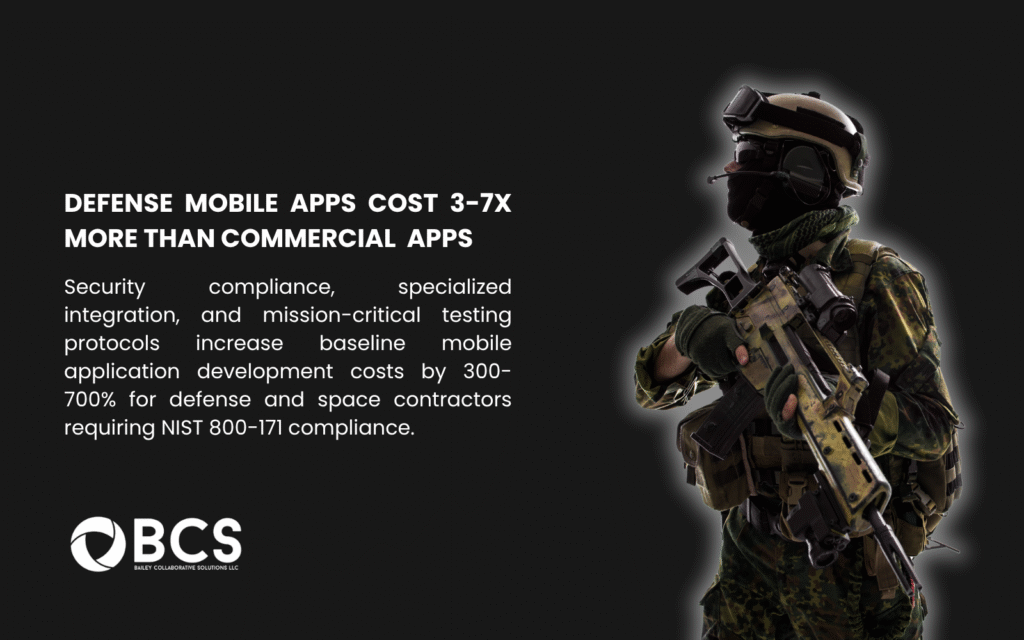
Real-Time Data Processing Cost Structures
Mission-critical mobile applications in defense and space environments require real-time data processing capabilities that exceed commercial application requirements by several orders of magnitude. The processing of telemetry data, sensor fusion information, and command and control signals demands specialized mobile application architecture designed for microsecond-level response times and fault-tolerant operation.
| Processing Requirement | Development Cost | Hardware Dependencies | Performance Impact |
| Real-Time Telemetry | $125,000 – $200,000 | Specialized Processors | <10ms Latency |
| Sensor Data Fusion | $95,000 – $160,000 | FPGA Integration | <5ms Processing |
| Command Processing | $110,000 – $185,000 | Redundant Systems | <1ms Response |
| Data Synchronization | $85,000 – $140,000 | Network Optimization | <50ms Sync |
| Error Correction | $70,000 – $120,000 | Memory Expansion | 99.99% Reliability |
Advanced modeling and simulation capabilities integrated within defense mobile applications require specialized mathematical processing libraries and computational frameworks that significantly impact development costs. These simulation engines must operate within constrained mobile environments while maintaining accuracy levels suitable for mission-critical decision support systems.
System Integration Complexity Analysis
Defense and space mobile applications rarely operate as standalone systems but require integration with existing command and control infrastructures, satellite communication networks, and legacy defense systems. This integration complexity represents one of the most significant cost drivers in mobile application development cost calculations for government contractors.
| Integration Type | Cost Range | Timeline Impact | Technical Risk |
| Legacy System Integration | $150,000 – $275,000 | 6-12 months | High |
| Satellite Communication | $200,000 – $350,000 | 8-14 months | Very High |
| Command & Control Systems | $175,000 – $300,000 | 7-13 months | High |
| Tactical Data Links | $125,000 – $225,000 | 5-10 months | Medium |
| Classified Network Access | $250,000 – $450,000 | 10-18 months | Very High |
The digital platform engineering approach required for defense mobile applications involves creating abstraction layers that enable seamless communication between mobile applications and existing defense infrastructure. This abstraction layer development represents substantial engineering effort that directly impacts overall project costs through specialized API development and protocol translation services.
Technical Implementation Cost Models
Development Phase Cost Distribution
Understanding the distribution of mobile application development costs across project phases enables more accurate budgeting and resource allocation for defense contractors. The unique requirements of defense and space applications alter traditional development phase cost distributions through extended security testing, specialized integration phases, and comprehensive validation protocols.
| Development Phase | Commercial Apps (%) | Defense/Space Apps (%) | Cost Driver |
| Requirements Analysis | 8-12% | 15-20% | Security Specifications |
| Architecture Design | 12-18% | 20-25% | System Integration |
| Core Development | 45-55% | 35-40% | Specialized Components |
| Security Implementation | 5-10% | 20-25% | Compliance Requirements |
| Testing & Validation | 15-20% | 25-35% | Mission-Critical Testing |
| Deployment & Integration | 8-12% | 15-20% | Secure Infrastructure |
The digital engineering tools required for defense mobile application development include specialized development environments, secure coding platforms, and automated security testing frameworks. These tools represent additional licensing and infrastructure costs that impact overall mobile application development cost through specialized software requirements and secure development environment maintenance.
Resource Allocation Cost Analysis
Defense mobile application development requires specialized personnel with security clearances and domain expertise in defense systems architecture. The scarcity of cleared personnel with mobile development expertise creates premium labor costs that significantly impact overall project budgets.
| Resource Type | Commercial Rate | Defense Rate | Premium Factor |
| Senior Mobile Developer | $95-120/hour | $140-180/hour | 1.5x |
| Security Architect | $110-140/hour | $165-220/hour | 1.6x |
| Systems Integration Engineer | $100-130/hour | $150-200/hour | 1.5x |
| Test Engineer (Security) | $85-110/hour | $130-170/hour | 1.5x |
| Project Manager (Cleared) | $120-150/hour | $180-240/hour | 1.6x |
The model-based systems engineering methodology applied to mobile application development requires specialized modeling tools and simulation environments that increase development costs through software licensing and training requirements. These methodologies enable more accurate cost estimation and risk mitigation but require upfront investment in specialized engineering capabilities.
Advanced Technical Considerations
Computational Requirements and Performance Optimization
Defense mobile applications must operate within constrained computational environments while maintaining performance levels suitable for mission-critical operations. The optimization of mobile application architecture for these constraints requires specialized development approaches that impact overall project costs through performance engineering and optimization efforts.
| Performance Metric | Commercial Target | Defense Target | Engineering Effort |
| Response Time | <500ms | <50ms | 10x Optimization |
| Memory Utilization | <200MB | <100MB | 2x Constraint |
| Battery Life | 8-12 hours | 24-48 hours | 3x Optimization |
| Network Efficiency | Standard | Bandwidth Limited | 5x Optimization |
| Fault Tolerance | 99% Uptime | 99.99% Uptime | 10x Reliability |
The digital quality engineering practices required for defense mobile applications include comprehensive performance testing, security validation, and reliability assessment that extends beyond commercial testing protocols. These quality assurance measures represent substantial cost components that must be factored into mobile application development cost estimates.
Lifecycle Management and Maintenance Costs
Defense mobile applications require specialized lifecycle management approaches that account for security patching, compliance updates, and integration maintenance with evolving defense systems infrastructure. The long-term maintenance costs for these applications exceed commercial maintenance requirements through specialized support requirements and security compliance obligations.
| Maintenance Category | Annual Cost Range | Update Frequency | Compliance Impact |
| Security Patches | $50,000 – $85,000 | Monthly | NIST 800-171 |
| System Integration Updates | $75,000 – $125,000 | Quarterly | DoD Standards |
| Performance Optimization | $40,000 – $70,000 | Bi-annually | Mission Requirements |
| Compliance Auditing | $60,000 – $100,000 | Annually | Government Standards |
| Infrastructure Updates | $80,000 – $140,000 | As Required | Technology Evolution |
The system development life cycle approach for defense mobile applications requires extended maintenance phases that account for evolving security threats, changing compliance requirements, and integration with upgraded defense systems infrastructure. These lifecycle considerations significantly impact total cost of ownership calculations beyond initial development expenses.
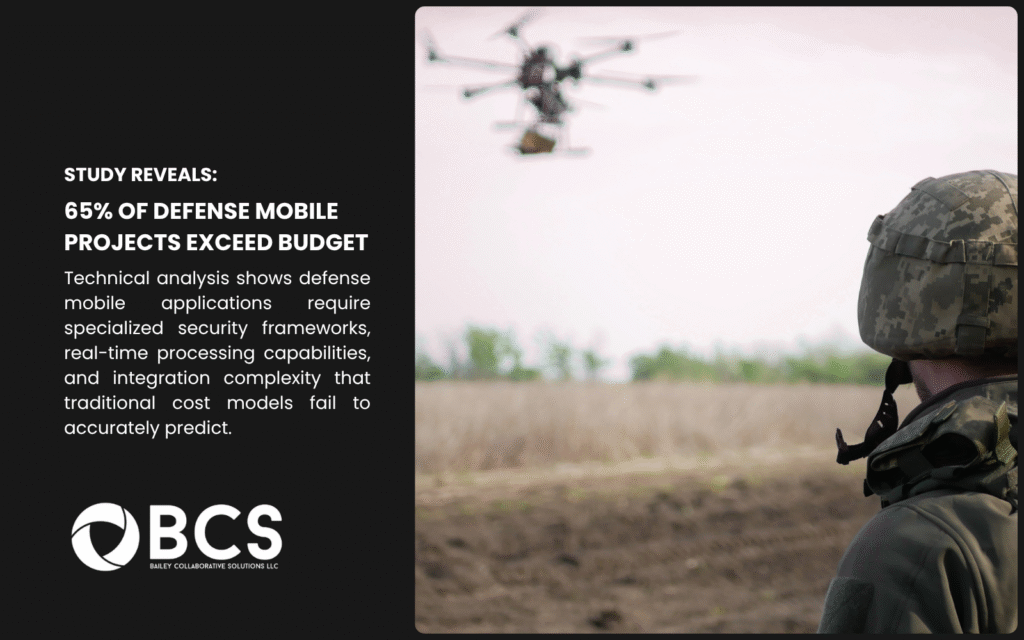
Technical Risk Assessment and Mitigation Costs
Security Risk Mitigation Framework
Defense mobile applications face unique security risks that require specialized mitigation strategies and associated cost implications. The threat landscape for defense applications includes nation-state actors, advanced persistent threats, and sophisticated attack vectors that exceed commercial security concerns.
| Risk Category | Mitigation Cost | Implementation Timeline | Success Metrics |
| Data Exfiltration | $125,000 – $200,000 | 6-9 months | Zero Data Loss |
| System Compromise | $150,000 – $250,000 | 8-12 months | <1% Compromise Rate |
| Communication Interception | $100,000 – $175,000 | 5-8 months | Military-Grade Encryption |
| Authentication Bypass | $75,000 – $125,000 | 4-7 months | Multi-Factor Security |
| Denial of Service | $90,000 – $160,000 | 5-9 months | 99.9% Availability |
The system architecture diagram development for defense mobile applications requires detailed threat modeling and security architecture documentation that increases design phase costs through specialized security analysis and documentation requirements.
Integration Risk Assessment
The complexity of integrating mobile applications with existing defense infrastructure creates technical risks that must be addressed through comprehensive testing and validation protocols. These risk mitigation efforts represent substantial cost components that impact overall mobile application development cost through extended testing phases and specialized validation procedures.
| Integration Risk | Probability | Impact Cost | Mitigation Strategy |
| Legacy System Incompatibility | Medium | $200,000 – $400,000 | Abstraction Layer Development |
| Protocol Mismatch | High | $150,000 – $300,000 | Custom Protocol Development |
| Performance Degradation | Medium | $100,000 – $200,000 | Optimization Engineering |
| Security Control Conflicts | High | $175,000 – $350,000 | Security Architecture Redesign |
| Data Format Inconsistencies | Medium | $125,000 – $250,000 | Translation Layer Implementation |
The software development life cycle for defense applications requires extended risk assessment phases that evaluate technical, security, and operational risks specific to defense environments. These assessment activities increase project timelines and costs through specialized risk analysis and mitigation planning efforts.
Technology Stack Cost Analysis
Specialized Development Frameworks
Defense mobile applications require specialized development frameworks and libraries that support security requirements, real-time processing capabilities, and integration with defense systems infrastructure. These specialized technology stacks impact mobile application development cost through licensing fees, training requirements, and specialized development expertise.
| Technology Component | Commercial Cost | Defense Cost | Capability Enhancement |
| Secure Mobile Framework | $25,000 – $50,000 | $75,000 – $150,000 | FIPS 140-2 Compliance |
| Real-Time Processing | $40,000 – $80,000 | $120,000 – $240,000 | Microsecond Response |
| Encryption Libraries | $15,000 – $30,000 | $60,000 – $120,000 | Military-Grade Security |
| Communication Protocols | $35,000 – $70,000 | $105,000 – $210,000 | Tactical Data Links |
| Database Systems | $50,000 – $100,000 | $150,000 – $300,000 | Classified Data Handling |
The digital product engineering approach for defense applications requires specialized technology evaluation and selection processes that account for security compliance, performance requirements, and long-term supportability within defense environments.
Development Environment Infrastructure
Defense mobile application development requires specialized development environments that provide security isolation, classified data handling capabilities, and integration with defense development tools and processes. These infrastructure requirements create additional costs beyond commercial development environment expenses.
| Infrastructure Component | Setup Cost | Annual Maintenance | Security Level |
| Secure Development Environment | $100,000 – $175,000 | $50,000 – $85,000 | Secret Clearance |
| Classified Network Access | $150,000 – $250,000 | $75,000 – $125,000 | Top Secret |
| Secure Testing Laboratory | $125,000 – $200,000 | $60,000 – $100,000 | Controlled Access |
| Code Repository Security | $75,000 – $125,000 | $35,000 – $60,000 | Encrypted Storage |
| Build and Deployment Pipeline | $90,000 – $150,000 | $45,000 – $75,000 | Automated Security |
The model-based systems engineering tools required for defense mobile application development include specialized modeling environments, simulation platforms, and analysis tools that support complex system architecture design and validation processes.
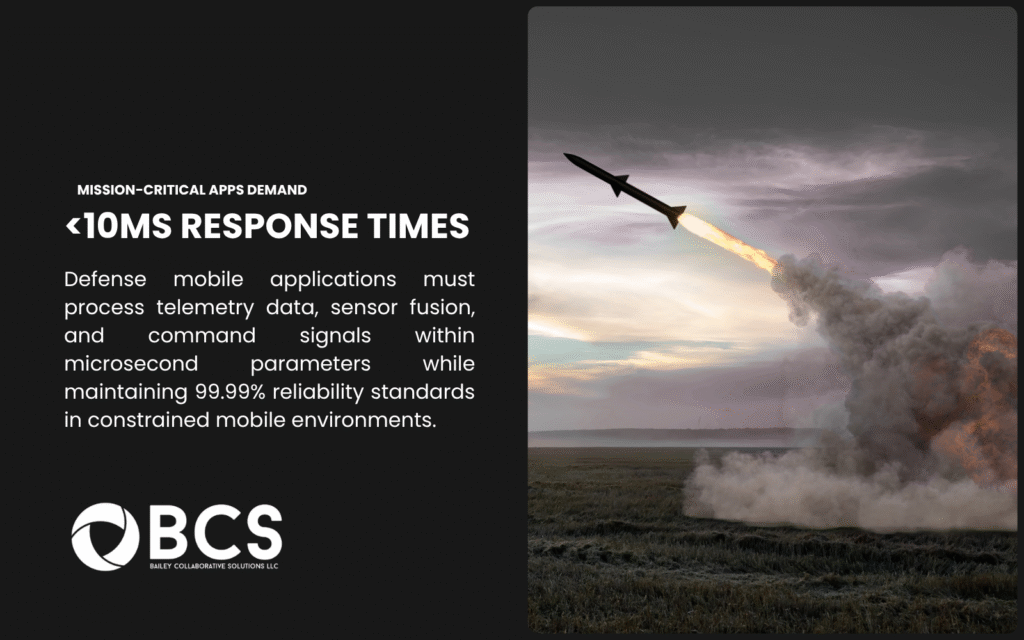
Strategic Cost Optimization Approaches
Modular Architecture Cost Benefits
Defense mobile applications benefit from modular architecture approaches that enable component reuse across multiple projects and reduce long-term maintenance costs through standardized interfaces and shared security frameworks. The initial investment in modular design creates cost savings opportunities for future projects within defense contractor portfolios.
| Modular Component | Development Cost | Reuse Savings | Implementation Timeline |
| Security Framework | $200,000 – $350,000 | 60-80% | 12-18 months |
| Communication Module | $150,000 – $250,000 | 50-70% | 8-14 months |
| Data Processing Engine | $175,000 – $300,000 | 55-75% | 10-16 months |
| User Interface Components | $100,000 – $175,000 | 40-60% | 6-12 months |
| Integration Middleware | $125,000 – $225,000 | 45-65% | 8-15 months |
The digital engineering future emphasizes modular architecture approaches that reduce mobile application development cost through component standardization and reuse strategies that benefit multiple defense contractor projects.
Technology Investment Strategy
Strategic technology investments in defense mobile application development create long-term cost advantages through platform standardization, development tool optimization, and process automation. These investments require upfront capital but generate significant cost reductions across multiple project cycles.
| Investment Area | Initial Cost | Annual Savings | ROI Timeline |
| Automated Testing Platform | $300,000 – $500,000 | $150,000 – $250,000 | 2-3 years |
| Security Framework | $400,000 – $700,000 | $200,000 – $350,000 | 2-4 years |
| Development Tools Suite | $200,000 – $350,000 | $100,000 – $175,000 | 2-3 years |
| Integration Platform | $350,000 – $600,000 | $175,000 – $300,000 | 2-4 years |
| Training and Certification | $150,000 – $250,000 | $75,000 – $125,000 | 2-3 years |
The system architecture space defense requirements drive technology investment decisions that impact long-term mobile application development cost through platform standardization and capability enhancement strategies.
Implementation Recommendations and Cost Projections
Phase-Gate Development Approach
Defense mobile application development benefits from phase-gate approaches that enable incremental capability delivery and risk mitigation through controlled development phases. This methodology reduces overall project risk while enabling cost optimization through iterative development and validation cycles.
| Development Phase | Duration | Cost Range | Key Deliverables |
| Concept Definition | 2-4 months | $100,000 – $200,000 | Requirements Specification |
| Architecture Design | 3-6 months | $200,000 – $400,000 | System Architecture |
| Prototype Development | 4-8 months | $300,000 – $600,000 | Proof of Concept |
| Full Development | 8-15 months | $800,000 – $1,500,000 | Production System |
| Integration Testing | 3-6 months | $250,000 – $500,000 | Validated System |
| Deployment Support | 2-4 months | $150,000 – $300,000 | Operational System |
The 7 stages of system development life cycle methodology provides structured approaches for managing complex defense mobile application projects while controlling costs through systematic development phase management.
Resource Optimization Strategies
Effective resource management strategies for defense mobile application development focus on balancing specialized expertise requirements with cost constraints through strategic resource allocation and skill development investments. These strategies enable cost optimization while maintaining technical capability requirements.
| Resource Strategy | Cost Impact | Implementation Complexity | Long-term Benefits |
| Cleared Personnel Development | -20% to -35% | High | Sustained Capability |
| Offshore Development (Limited) | -15% to -25% | Medium | Cost Reduction |
| Contractor Partnerships | -10% to -20% | Low | Flexibility |
| Tool Standardization | -25% to -40% | Medium | Efficiency Gains |
| Process Automation | -30% to -50% | High | Quality Improvement |
The software development life cycle phases for defense applications require specialized resource allocation strategies that balance security clearance requirements with technical expertise needs while managing overall project costs.
Technical Implementation Framework
Mobile application development cost optimization for defense and space applications requires a comprehensive understanding of technical requirements, security constraints, and integration complexities that differentiate these projects from commercial mobile development. The technical framework presented establishes cost analysis methodologies that enable accurate project estimation and resource allocation for government contractors pursuing mobile technology integration within defense systems portfolios.
The cost analysis reveals that defense mobile applications require specialized approaches that increase baseline development costs through security compliance, specialized integration requirements, and mission-critical reliability standards. However, strategic investment in modular architectures, standardized development frameworks, and automated testing platforms create long-term cost advantages that benefit multiple project cycles within defense contractor organizations.
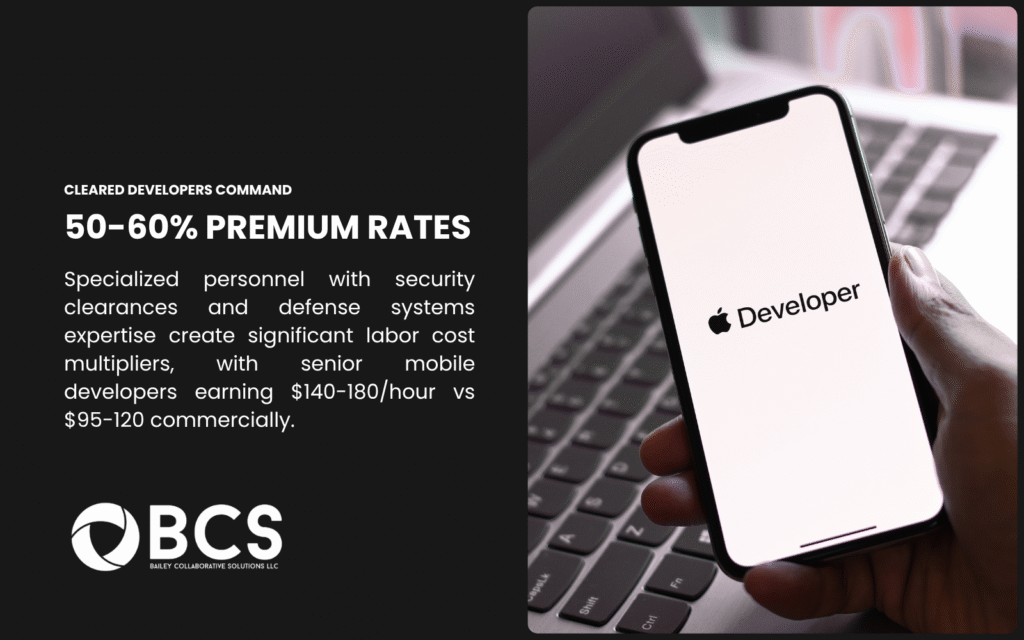
Successful mobile application development cost management in defense environments requires balancing technical requirements with fiscal constraints through systematic development approaches, strategic technology investments, and specialized resource management strategies. The implementation of these cost optimization approaches enables defense contractors to deliver mission-critical mobile capabilities while maintaining competitive project economics within government contracting environments.Defense contractors seeking to develop mobile applications for space and defense systems require specialized expertise in security architecture, systems integration, and compliance frameworks that exceed commercial development capabilities. Contact our technical team to discuss your mobile application development requirements and receive detailed cost analysis for your specific defense or space systems integration project. Our experienced engineering professionals provide the specialized knowledge and security clearances necessary for successful defense mobile application implementation. Partner with our technical experts to develop cost-effective mobile solutions that meet stringent defense and space systems requirements while maintaining project schedule and budget objectives.




